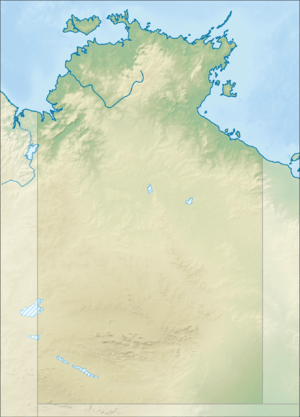Wessel Islands
The Wessel Islands is a group of islands in the Northern Territory of Australia. They extend in a more or less straight line from Buckingham Bay and the Napier Peninsula of Arnhem Land, and Elcho Island, to the northeast. Marchinbar Island is the largest of the group. Other islands include Elcho Island, Rimbija Island (the most outlying island), Guluwuru, Raragala, Stevens Island, Burgunngura, Djeergaree, Yargara, Drysdale Island, Jirrgari Island, Graham Island, Alger Island, Abbott Island, and Howard Island.

Bumaga Island and Warnawi Island, both part of the Wessel Islands group, are also part of the Cunningham Islands.
History
The Wessel Islands constituted the homelands of the Nango or Yan-nhaŋu.[1]
Marchinbar coins
In 1944, Australian soldier Morry Isenberg found nine coins buried in the sand one day while fishing when he was stationed on Marchinbar Island. In 1979 he sent these coins to be authenticated. Four of the coins were found to have come from the Dutch East India Company, while the other five were determined to be from the Kilwa Sultanate in Tanzania. Their re-examination has given rise to much speculation about how these medieval African coins came to Australia.[2] Another coin, believed to be from Kilwa turned up on Elcho Island where it was found by Past Masters amateur archaeologist Mike Hermes in 2018.[3]
European discovery and naming
The islands were mapped and named by a Dutch expedition that sailed from Banda Neira to explore the coasts of New Guinea and the South Land following up on discoveries made in 1623 by Jan Carstensz and Willem van Colster (who named Arnhem Land after his ship Arnhem.[4][5] The expedition used two small yachts that had been prefabricated in the Netherlands and were assembled on the Banda Islands, the Cleen Amsterdam and the Wesel.[6] The ships sailed on 17 April 1636 under the command of Gerrit Thomas Pool, who was killed on New Guinea just 11 days later. The merchant Pieter Pieterszoon took over command and continued the voyage, returning to Banda. Besides the Wesel Eilanden, named after the ship, Pietersen described the Cobourg Peninsula, Melville Island (Roode hoek), and Dundas Strait (which he misidentified as a bay).[7] 170 years later Matthew Flinders decided to retain the name of the islands, though he slightly modified it to Wessel.[8] The cities of Arnhem and Wesel, ultimate sources of the names of Arnhem Land and Wessel Islands, are themselves only 60 km (37 miles) separated.
Later history
Much of the population of the Wessel Islands was decimated by smallpox, introduced from Makassar, during the 1790s. By the early nineteenth century, many of the Yolngnu clans had been wiped out.[9]
During WW2, a string of observational outposts were set up along the Wessel Islands. A minesweeper, the Patricia Cam was sunk by a Japanese float plane on 22 January 1943. A Yolgnu account of the incident, and attempts to save the survivors was taken down from one of the latter, Narritjin Maymuru.[10]
Ecoregion
Wessel is the name of the IBRA region based on the Islands area, as well as the commonwealth marine reserve[11]
See also
- Abbott Island (Wessel Islands)
- Annelies Islands
Notes
Citations
- Tindale 1974, p. 232.
- McIntosh 2012, pp. 9–26.
- Judd & Trevaskis 2018.
- Kirk 2012, p. 29.
- PMI.
- Heeres 1899, p. viii,64-67.
- Heeres 1899, p. viii.
- Flinders 1814, p. 246.
- McIntosh 2012, p. 21.
- Long 1992, pp. 83–84.
- ERIN 2012.
Sources
- "A Pictorial History of ELCHO ISLAND". Past Masters International.
- ERIN (2012). "Wessel Commonwealth Marine Reserve" (PDF). Department of Sustainability, Environment, Water, Population and Communities.CS1 maint: ref=harv (link)
- Flinders, Matthew (1814). A voyage to terra Australis..in the years 1801-1803. London: Bulmer.CS1 maint: ref=harv (link)
- Heeres, Jan Ernst (1899). Het aandeel der Nederlanders in de ontdekking van Australië 1606-1765. E.J. Brill.CS1 maint: ref=harv (link)
- Judd, Bridget; Trevaskis, Liz (10 July 2018). "Coin found off Arnhem Land coast could be among Australia's oldest foreign artefacts". ABC Radio Darwin.CS1 maint: ref=harv (link)
- Kirk, Robert W. (2012). Paradise Past: The Transformation of the South Pacific, 1520–1920. McFarland & Company. ISBN 978-0-786-49298-5.CS1 maint: ref=harv (link)
- Long, Jeremy (1992). "The Sinking of the "Patricia Cam": Narritjin's s Story". Aboriginal History. Australian National University Press. 16 (1–2): 81–84. JSTOR 24046211.CS1 maint: ref=harv (link)
- McIntosh, Ian S. (2012). "Life and Death on the Wessel Islands: The Case of Australia's Mysterious African Coin Cache" (PDF). Australian Folklore. 27: 9–26.CS1 maint: ref=harv (link)
- Tindale, Norman Barnett (1974). "Nango (NT)". Aboriginal Tribes of Australia: Their Terrain, Environmental Controls, Distribution, Limits, and Proper Names. Australian National University. ISBN 978-0-708-10741-6.CS1 maint: ref=harv (link)